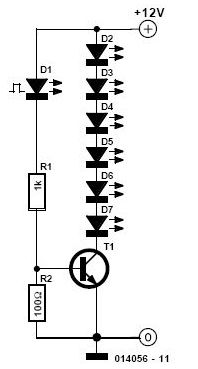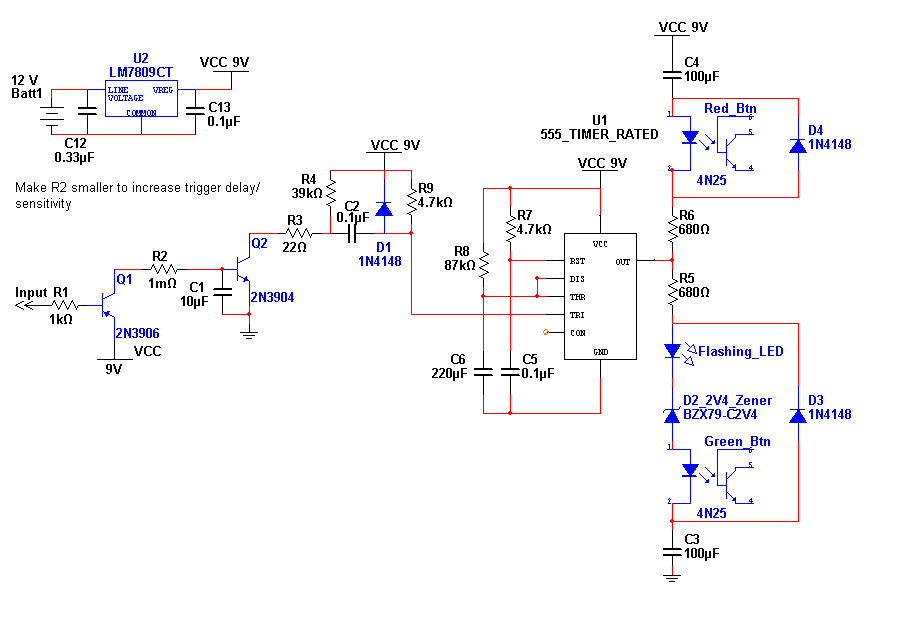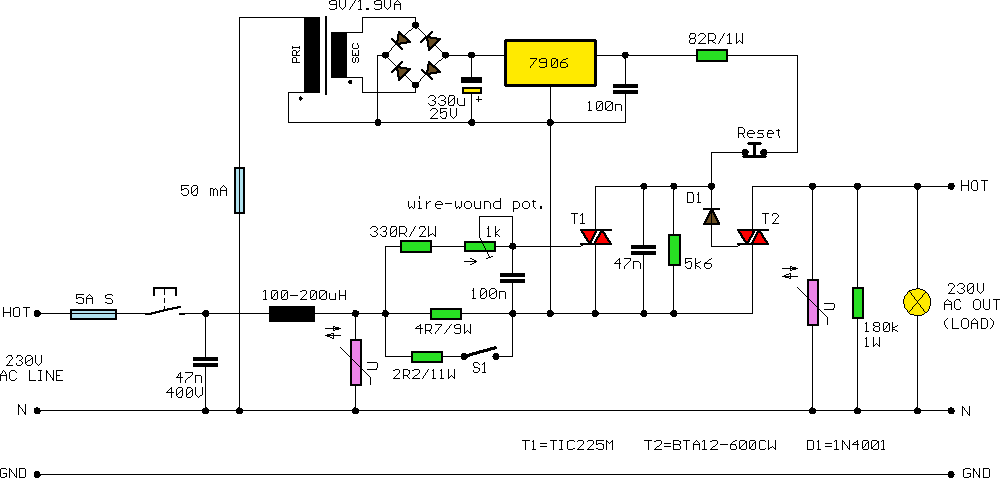
555 timer Clap switch circuit electronic project

This 555 timer clap switch circuit electronic project is designed using common electronic components. The circuit operates from a distance of up to 10 meters from the microphone. The signal from the microphone is amplified by transistors T1, T2, and T3. Diode D1 detects clap signals, and the resulting positive voltage is applied to the base of transistor T4. Transistor T5 amplifies the output signal from T4 and triggers the monostable multivibrator based on the 555 timer IC. The output signal from the 555 timer IC serves as a clock for a 4017 decade counter. With each successive clap, T6 conducts and alternately cuts off, resulting in the switching on and off of a lamp. The triac used for this project can be an 8T44A or ST044 and can drive a load with a rating of up to 4 amps. The 12 volts required to power this electronic circuit project is derived directly from the mains using rectifier diode D2 along with other components like resistor R16 and ZD1 zener diode.
This clap switch circuit utilizes a 555 timer IC configured in monostable mode to create a responsive lighting system activated by sound. The microphone acts as a sensor, picking up clap sounds, which are then amplified through a series of transistors (T1, T2, and T3) to ensure the signal is strong enough for processing. Diode D1 plays a crucial role in detecting the clap sound, converting the audio signal into a usable voltage signal that triggers T4.
Transistor T5 serves to further amplify the signal, ensuring that the 555 timer receives a sufficient input to activate. The 4017 decade counter receives pulses from the 555 timer output, allowing for sequential activation of connected loads, such as lamps. The use of transistor T6 allows for alternating control of the lamp, enabling it to switch on and off with each clap detected.
The circuit's power supply is ingeniously derived from the mains voltage, with diode D2 functioning as a rectifier to convert AC to DC. Resistor R16 and zener diode ZD1 work together to stabilize the voltage at 12 volts, ensuring consistent operation of the entire circuit. The choice of triac, such as the 8T44A or ST044, is critical, as it must handle the load current effectively, rated at up to 4 amps, making it suitable for driving various light sources. Overall, this clap switch circuit exemplifies an efficient design that merges audio detection with practical lighting control, demonstrating the versatility of the 555 timer IC in electronic projects.This 555timer clap switch circuit electronic project is designed using some common electronic parts. This 555 timer clap switch circuit electronic project operates from a distance of up to 10 meters from the microphone. Signal from microphone is amplified by transistors T1, T2 and T3. Diode D1 detects clap signals and the resulting positive volt age is applied to the base of the transistor T4. T5 transistor will amplify the output signal from the T4 transistor and will trigger the monostable multivibrator based on the 555 timer IC. The output signal from the 555 timer IC is used as a clock for a 4017 decade counter. For each successive clap T6 conducts and cuts off alternately, resulting and on of switching for the lamp.
Triac used for this project can be a 8T44A or ST044 and can drive load up to 4 amp rating. The 12 volt for powering this electronic circuit project is derived directly from the mains using rectifier diode D2 and some other components like R16 and ZD1 zener diode. 🔗 External reference
This clap switch circuit utilizes a 555 timer IC configured in monostable mode to create a responsive lighting system activated by sound. The microphone acts as a sensor, picking up clap sounds, which are then amplified through a series of transistors (T1, T2, and T3) to ensure the signal is strong enough for processing. Diode D1 plays a crucial role in detecting the clap sound, converting the audio signal into a usable voltage signal that triggers T4.
Transistor T5 serves to further amplify the signal, ensuring that the 555 timer receives a sufficient input to activate. The 4017 decade counter receives pulses from the 555 timer output, allowing for sequential activation of connected loads, such as lamps. The use of transistor T6 allows for alternating control of the lamp, enabling it to switch on and off with each clap detected.
The circuit's power supply is ingeniously derived from the mains voltage, with diode D2 functioning as a rectifier to convert AC to DC. Resistor R16 and zener diode ZD1 work together to stabilize the voltage at 12 volts, ensuring consistent operation of the entire circuit. The choice of triac, such as the 8T44A or ST044, is critical, as it must handle the load current effectively, rated at up to 4 amps, making it suitable for driving various light sources. Overall, this clap switch circuit exemplifies an efficient design that merges audio detection with practical lighting control, demonstrating the versatility of the 555 timer IC in electronic projects.This 555timer clap switch circuit electronic project is designed using some common electronic parts. This 555 timer clap switch circuit electronic project operates from a distance of up to 10 meters from the microphone. Signal from microphone is amplified by transistors T1, T2 and T3. Diode D1 detects clap signals and the resulting positive volt age is applied to the base of the transistor T4. T5 transistor will amplify the output signal from the T4 transistor and will trigger the monostable multivibrator based on the 555 timer IC. The output signal from the 555 timer IC is used as a clock for a 4017 decade counter. For each successive clap T6 conducts and cuts off alternately, resulting and on of switching for the lamp.
Triac used for this project can be a 8T44A or ST044 and can drive load up to 4 amp rating. The 12 volt for powering this electronic circuit project is derived directly from the mains using rectifier diode D2 and some other components like R16 and ZD1 zener diode. 🔗 External reference





